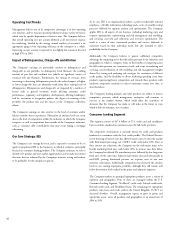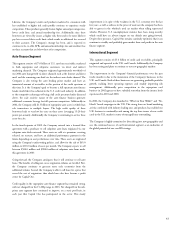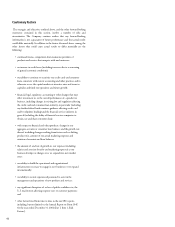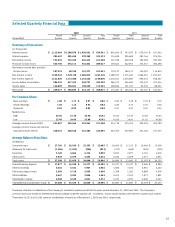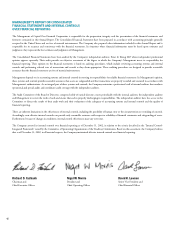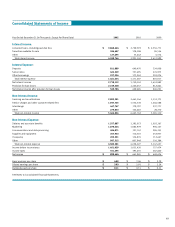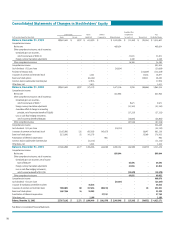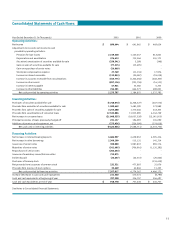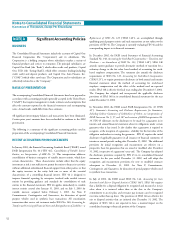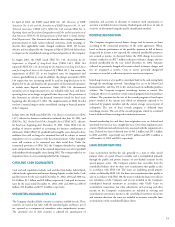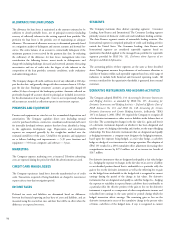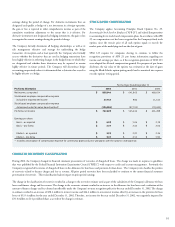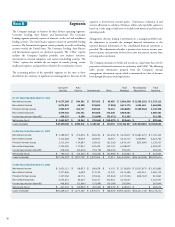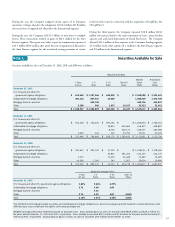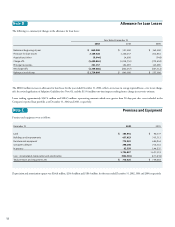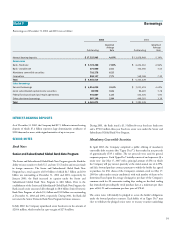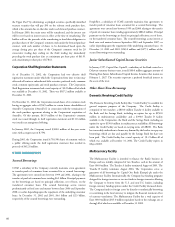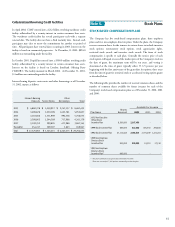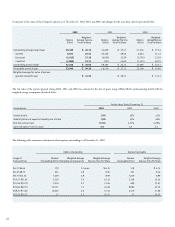Capital One 2002 Annual Report Download - page 54
Download and view the complete annual report
Please find page 54 of the 2002 Capital One annual report below. You can navigate through the pages in the report by either clicking on the pages listed below, or by using the keyword search tool below to find specific information within the annual report.
52
Replacement of SFAS No. 125 (“SFAS 140”), are accomplished through
qualifying special purpose entities and such transactions are not subject to the
provisions of FIN 46. The Company is currently evaluating FIN 46 and the
corresponding impact to its financial statements.
In December 2002, the FASB issued Statement of Financial Accounting
Standard No. 148, Accounting for Stock-Based Compensation – Transition and
Disclosure – an Amendment of SFAS No. 123, (“SFAS 148”). SFAS 148
amends current guidance to provide alternative methods of transition for a
voluntary change to the fair value based method of accounting for stock-
based employee compensation. The statement also amends the disclosure
requirements of SFAS No. 123, Accounting for Stock-Based Compensation
(“SFAS 123”), to require prominent disclosures in both annual and interim
financial statements about the method of accounting for stock-based
employee compensation and the effect of the method used on reported
results. SFAS 148 is effective for fiscal years ending after December 15, 2002.
The Company has adopted and incorporated the applicable disclosure
provisions of SFAS 148 in its consolidated financial statements for the year
ended December 31, 2002.
In November 2002, the FASB issued FASB Interpretation No. 45 (“FIN
45”), Guarantor’s Accounting and Disclosure Requirements for Guarantees,
Including Indirect Guarantees of Indebtedness of Others, an interpretation of
FASB Statements No. 5, 57, and 107 and rescission of FASB Interpretation No.
34. FIN 45 elaborates on the disclosures to be made by a guarantor in its
interim and annual financial statements about its obligations under certain
guarantees that it has issued. It also clarifies that a guarantor is required to
recognize, at the inception of a guarantee, a liability for the fair value of the
obligation undertaken in issuing the guarantee. FIN 45 requires the initial
disclosure of applicable guarantees in all issuances of financial statements of
interim or annual periods ending after December 15, 2002. The additional
provisions for initial recognition and measurement are effective on a
prospective basis for guarantees that are issued or modified after December
31, 2002, irrespective of a guarantor’s year-end. The Company has adopted
the disclosure provisions required by FIN 45 in its consolidated financial
statements for the year ended December 31, 2002, and will adopt the
recognition and measurement provisions for new or modified contracts
subsequent to December 31, 2002. See Note P, Commitments,
Contingencies and Guarantees, for discussion of special purpose vehicles used
in synthetic lease transactions.
In July of 2002, the FASB issued SFAS No. 146, Accounting for Costs
Associated with Exit or Disposal Activities (“SFAS 146”). SFAS 146 requires
that a liability for a disposal obligation be recognized and measured at its fair
value when it is incurred rather then at the date to the Company’s
commitment to an exit plan, and severance pay in many cases be recognized
over time rather than up front. The provisions of SFAS 146 are effective for
exit or disposal activities that are initiated after December 31, 2002. The
adoption of SFAS 146 is not expected to have a material impact on the
consolidated earnings or financial position of the Company.
Notes to Consolidated Financial Statements
(Currencies in Thousands, Except Per Share Data)
NOTE A Significant Accounting Policies
BUSINESS
The Consolidated Financial Statements include the accounts of Capital One
Financial Corporation (the “Corporation”) and its subsidiaries. The
Corporation is a holding company whose subsidiaries market a variety of
financial products and services to consumers. The principal subsidiaries are
Capital One Bank (the “Bank”), which offers credit card products, Capital
One, F.S.B. (the “Savings Bank”), which offers consumer lending (including
credit cards) and deposit products, and Capital One Auto Finance, Inc.
(“COAF”) which offers auto loans. The Corporation and its subsidiaries are
collectively referred to as the “Company.”
BASIS OF PRESENTATION
The accompanying Consolidated Financial Statements have been prepared in
accordance with accounting principles generally accepted in the United States
(“GAAP”) that require management to make estimates and assumptions that
affect the amounts reported in the financial statements and accompanying
notes. Actual results could differ from these estimates.
All significant intercompany balances and transactions have been eliminated.
Certain prior years’ amounts have been reclassified to conform to the 2002
presentation.
The following is a summary of the significant accounting policies used in
preparation of the accompanying Consolidated Financial Statements.
RECENT ACCOUNTING PRONOUNCEMENTS
In January 2003, the Financial Accounting Standards Board (“FASB”) issued
FASB Interpretation No. 46 (“FIN 46”), Consolidation of Variable Interest
Entities, an Interpretation of ARB No. 51. This interpretation addresses
consolidation of business enterprises of variable interest entities, which have
certain characteristics. These characteristics include either that the equity
investment at risk is not sufficient to permit the entity to finance its activities
without additional subordinated financial support from other parties; or that
the equity investors in the entity lack one or more of the essential
characteristics of a controlling financial interest. FIN 46 is designed to
improve financial reporting by enterprises involved with variable interest
entities by providing guidance and standards for consolidation of such
entities in the financial statements. FIN 46 applies immediately to variable
interest entities created after January 31, 2003, and on July 1, 2003 for
variable interests acquired before February 1, 2003. See Note P,
Commitments, Contingencies and Guarantees, for discussion of special
purpose vehicles used in synthetic lease transactions. All securitization
transactions that receive sale treatment under SFAS No. 140, Accounting for
Transfers and Servicing of Financial Assets and Extinguishment of Liabilities – a


